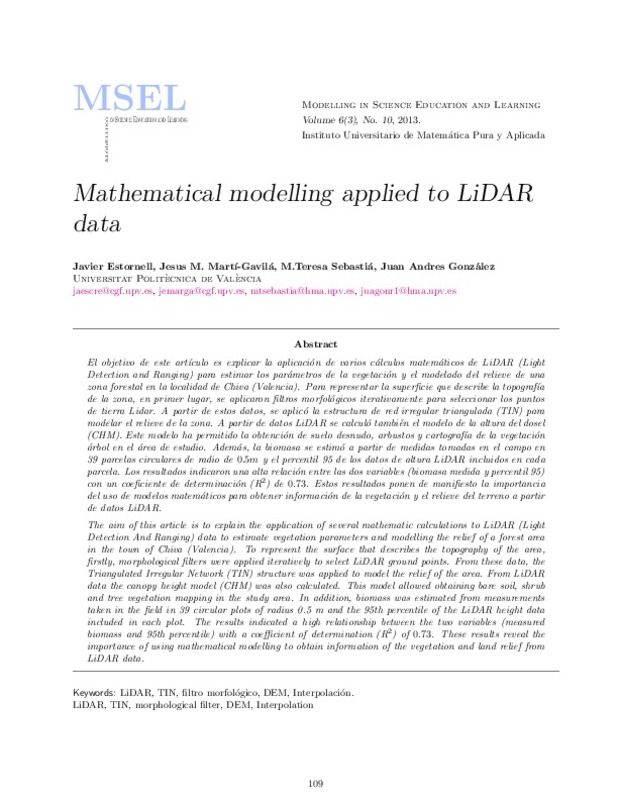JavaScript is disabled for your browser. Some features of this site may not work without it.
Buscar en RiuNet
Listar
Mi cuenta
Estadísticas
Ayuda RiuNet
Admin. UPV
Mathematical modelling applied to LiDAR data
Mostrar el registro sencillo del ítem
Ficheros en el ítem
| dc.contributor.author | Estornell, Javier
|
es_ES |
| dc.contributor.author | Martí-Gavilá, Jesus M.
|
es_ES |
| dc.contributor.author | Sebastiá, M. Teresa
|
es_ES |
| dc.contributor.author | González, Juan Andres
|
es_ES |
| dc.date.accessioned | 2018-04-19T08:11:42Z | |
| dc.date.available | 2018-04-19T08:11:42Z | |
| dc.date.issued | 2013-06-02 | |
| dc.identifier.uri | http://hdl.handle.net/10251/100635 | |
| dc.description.abstract | [EN] The aim of this article is to explain the application of several mathematic calculations to LiDAR (Light Detection And Ranging) data to estimate vegetation parameters and modelling the relief of a forest area in the town of Chiva (Valencia). To represent the surface that describes the topography of the area, firstly, morphological filters were applied iteratively to select LiDAR ground points. From these data, the Triangulated Irregular Network (TIN) structure was applied to model the relief of the area. From LiDAR data the canopy height model (CHM) was also calculated. This model allowed obtaining bare soil, shrub and tree vegetation mapping in the study area. In addition, biomass was estimated from measurements taken in the field in 39 circular plots of radius 0.5 m and the 95th percentile of the LiDAR height datanincluded in each plot. The results indicated a high relationship between the two variables (measurednbiomass and 95th percentile) with a coeficient of determination (R2) of 0:73. These results reveal the importance of using mathematical modelling to obtain information of the vegetation and land relief from LiDAR data. | es_ES |
| dc.description.abstract | [ES] El objetivo de este artículo es explicar la aplicación de varios cálculos matemáticos de LiDAR (Light Detection and Ranging) para estimar los parámetros de la vegetación y el modelado del relieve de una zona forestal en la localidad de Chiva (Valencia). Para representar la superficie que describe la topografía de la zona, en primer lugar, se aplicaron filtros morfológicos iterativamente para seleccionar los puntos de tierra Lidar. A partir de estos datos, se aplicó la estructura de red irregular triangulada (TIN) para modelar el relieve de la zona. A partir de datos LiDAR se calculó también el modelo de la altura del dosel (CHM). Este modelo ha permitido la obtención de suelo desnudo, arbustos y cartografía de la vegetación árbol en el área de estudio. Además, la biomasa se estimó a partir de medidas tomadas en el campo en 39 parcelas circulares de radio de 0:5m y el percentil 95 de los datos de altura LiDAR incluidos en cada parcela. Los resultados indicaron una alta relación entre las dos variables (biomasa medida y percentil 95) con un coeficiente de determinación (R2) de 0:73. Estos resultados ponen de manifiesto la importancia del uso de modelos matemáticos para obtener información de la vegetación y el relieve del terreno a partir de datos LiDAR. | es_ES |
| dc.language | Inglés | es_ES |
| dc.publisher | Universitat Politècnica de València | |
| dc.relation.ispartof | Modelling in Science Education and Learning | |
| dc.rights | Reconocimiento - No comercial (by-nc) | es_ES |
| dc.subject | LiDAR | es_ES |
| dc.subject | TIN | es_ES |
| dc.subject | Filtro morfológico | es_ES |
| dc.subject | DEM | es_ES |
| dc.subject | Interpolación | es_ES |
| dc.subject | Morphological filter | es_ES |
| dc.subject | Interpolation | es_ES |
| dc.title | Mathematical modelling applied to LiDAR data | es_ES |
| dc.type | Artículo | es_ES |
| dc.date.updated | 2018-04-19T06:38:14Z | |
| dc.identifier.doi | 10.4995/msel.2013.1988 | |
| dc.rights.accessRights | Abierto | es_ES |
| dc.description.bibliographicCitation | Estornell, J.; Martí-Gavilá, JM.; Sebastiá, MT.; González, JA. (2013). Mathematical modelling applied to LiDAR data. Modelling in Science Education and Learning. 6(3):109-118. https://doi.org/10.4995/msel.2013.1988 | es_ES |
| dc.description.accrualMethod | SWORD | es_ES |
| dc.relation.publisherversion | https://doi.org/10.4995/msel.2013.1988 | es_ES |
| dc.description.upvformatpinicio | 109 | es_ES |
| dc.description.upvformatpfin | 118 | es_ES |
| dc.type.version | info:eu-repo/semantics/publishedVersion | es_ES |
| dc.description.volume | 6 | |
| dc.description.issue | 3 | |
| dc.identifier.eissn | 1988-3145 |








